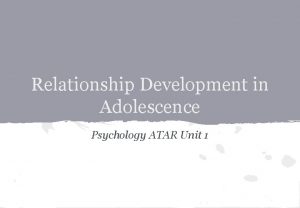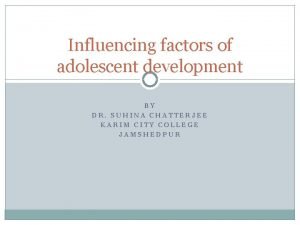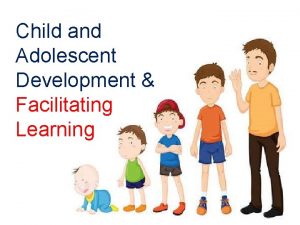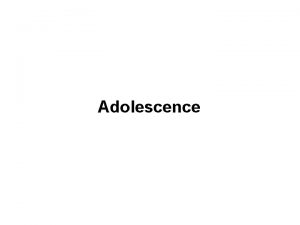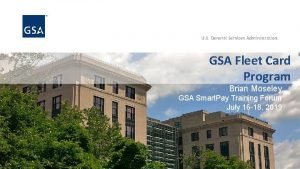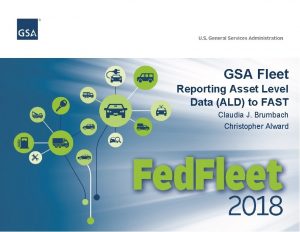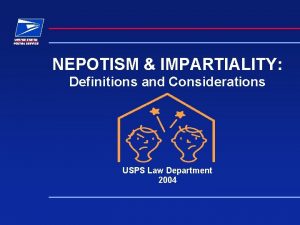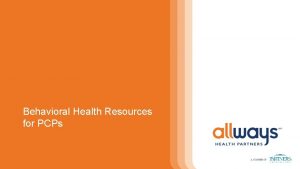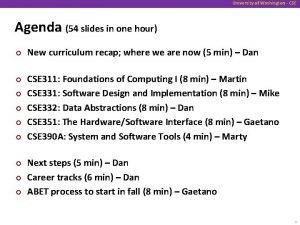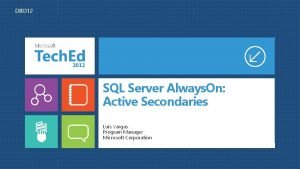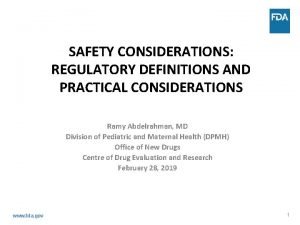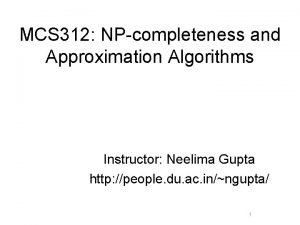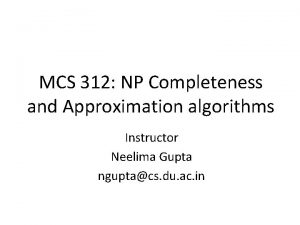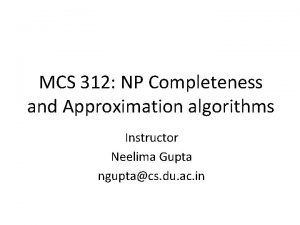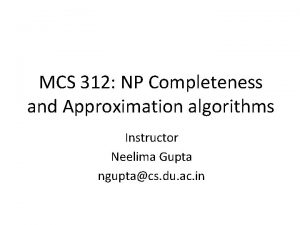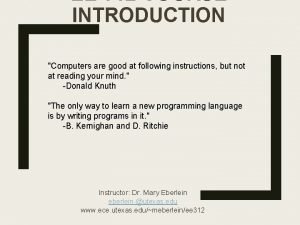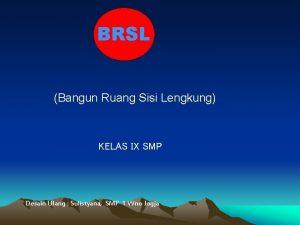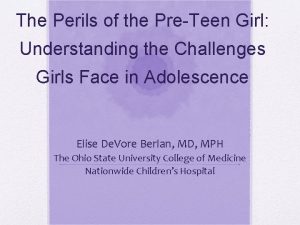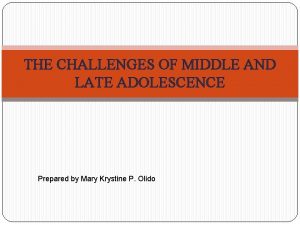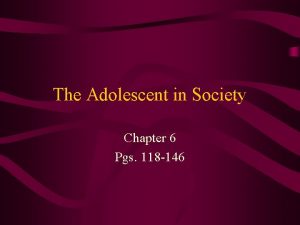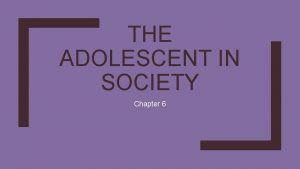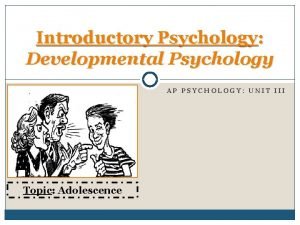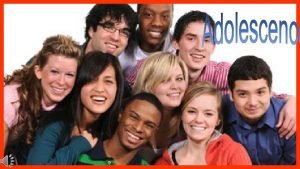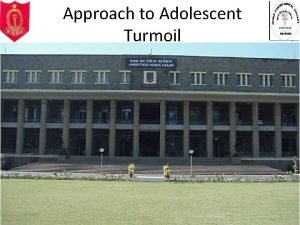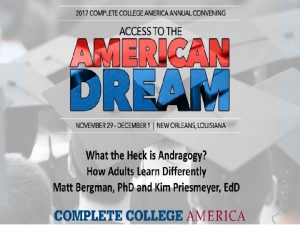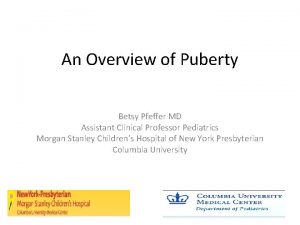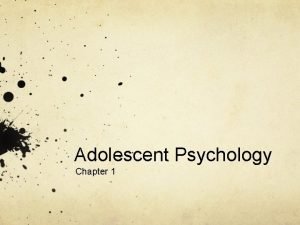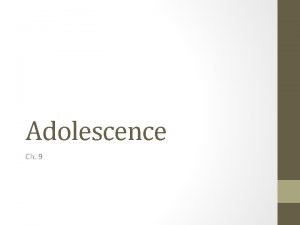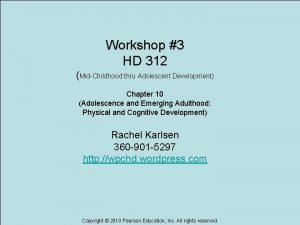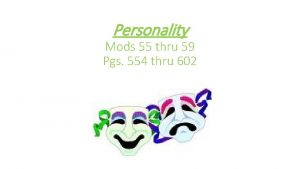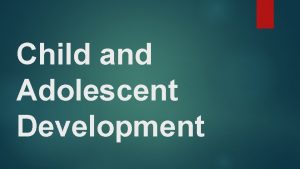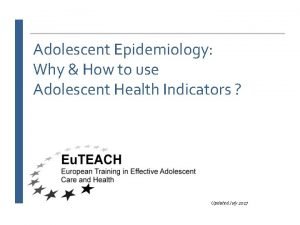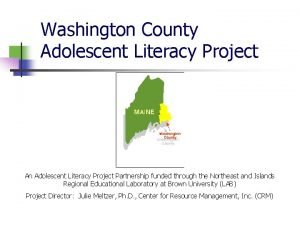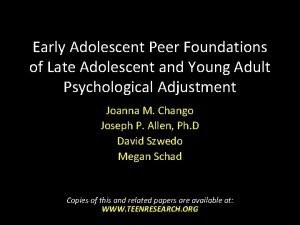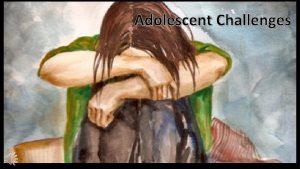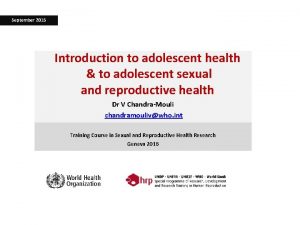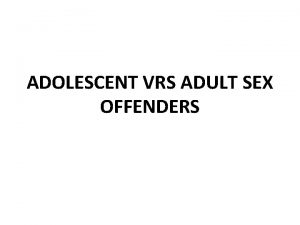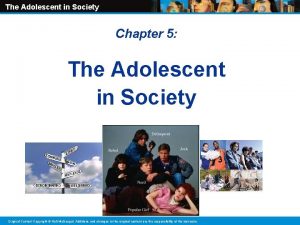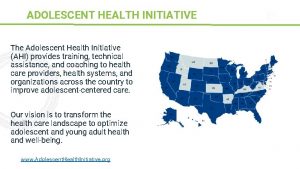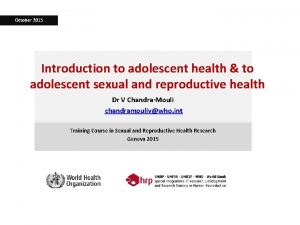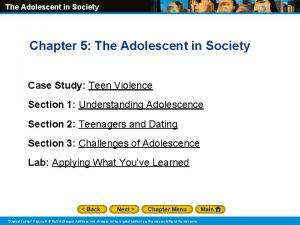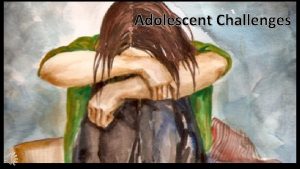Workshop 4 HD 312 MidChildhood thru Adolescent Development


























































- Slides: 58

Workshop #4 HD 312 (Mid-Childhood thru Adolescent Development) Chapter 11 (Adolescence and Emerging Adulthood: Personality and Sociocultural Development) Rachel Karlsen 360 -901 -5297 http: //wpchd. wordpress. com Copyright © 2010 Pearson Education, Inc. All rights reserved.

Welcome! John 14: 9 • Jesus said to him, “…. . Whoever has seen me has seen the Father…. ” • Reading passage: The Shack, by William Paul Young. p. 203 -204 • Poem: The Best Poem in the World – While I am busy tolerating others, they are also tolerating me. • Prayer? Copyright © 2010 Pearson Education, Inc. All rights reserved.

Adolescence and Emerging Adulthood Personality and Sociocultural Development Topics include: • Developmental Tasks of Adolescence • Family Dynamics • Peer Relationships During Adolescence • Risk and Resilience in Adolescence • Stress, Depression, and Coping Copyright © 2010 Pearson Education, Inc. All rights reserved.

Learning objectives: • Observe peer interaction and demonstrate critical thinking about the role of peer influence, media, stereotypes and bias in adolescent culture today • Identify and describe the major social-emotional developmental tasks of adolescents • Articulate Marcia’s theory on identity status • Evaluate cause and effect factors in typical adolescent family dynamic scenarios • Describe the characteristics and role of adolescent relationships with peers • Identify and examine common issues and high-risk behaviors affecting adolescents Copyright © 2010 Pearson Education, Inc. All rights reserved.

Approximate Schedule • 6: 00 -7: 15 Greeting, Bible inspiration, opening activity (4 corners), AWARE presentation, HS teacher presentation • 7: 15 -7: 30 Discussion of reading • 7: 30 -8: 00 Break • 8: 00 -8: 45 Developmental notes, discussion, activities. • 8: 45 -9: 45 Video (Surviving High School) • 9: 45 -10: 00 Connect with group, exit/participation papers Copyright © 2010 Pearson Education, Inc. All rights reserved.

Four Corners • Directions: – Four discussion scenarios will be described. Choose the topic you would like to discuss. Go to that corner and share your opinions and perspectives. A representative from each group will then report the central themes and range of ideas from the group’s discussion. Red: Blue: Green: Yellow: Dropping out and prison rates Firsts Dating Suicide Copyright © 2010 Pearson Education, Inc. All rights reserved.

Dropping out and prison rates Red group There has been a recent rise in the numbers of high school students leaving school before receiving a diploma. The rates are highest among minority students. Because research shows that dropouts are at higher risk of committing crimes and ending up in prison, some believe that lowering the dropout rate might lead to a decrease in the prison population in the U. S. , which has also risen over the last decade. Copyright © 2010 Pearson Education, Inc. All rights reserved.

Firsts Blue group The teenage years are a time of firsts – first infatuations, first sexual encounters, first experimentations with alcohol and possibly drugs. Teenagers learn to drive, take on their first paid employment, and by 18 years of age are expected to begin voting. Teens are also expected to plan a future, deciding on whether to go to college and if so, what course of study to pursue. Adults may not take into account just how dramatically life changes for adolescents from the age of 12 to 18. Copyright © 2010 Pearson Education, Inc. All rights reserved.

Dating Green group When would you let your adolescent begin to date? Discuss the types of dates and at what age you would let them begin dating. For example, dating can be in groups that meet at a designated place or as a couple that goes somewhere in a car. What effect would the sex of the adolescent play? Would you have a double standard for males and females? Copyright © 2010 Pearson Education, Inc. All rights reserved.

Suicide Yellow group • Suicide rates for teens have risen over the last several decades. Gay and lesbian teens are especially at risk for experiencing depression and attempting suicide. Copyright © 2010 Pearson Education, Inc. All rights reserved.

Assignments due tonight: Workshop #4 • Reading: Craig, Chapter 11 and Hersch, Chapters 12 postscript • Reading Response #4. Choose one of the following teens from A Tribe Apart and discuss the development, environmental and organic (personality/temperament) factors that you see being primary influences in each teen’s choices, reactions and relationships. (Joan, Courtney and Ann (compare/contrast), Charles, Jonathan, Brendon, Jessica, Chris. See rubrics. • Learning Team: – Presentation of product to authentic audience. – Prepare presentation of final project for Workshop Five. Copyright © 2010 Pearson Education, Inc. All rights reserved.

Assignments due next week Final workshop • Send papers attached through email, if possible (I will email back the paper/rubric) • Complete reflective essay on project (rubric posted at http: //wpchd. wordpress. com) • Project presentation • Learning team: – Present final project to class – Complete and turn in End of Course Learning Team Evaluation Copyright © 2010 Pearson Education, Inc. All rights reserved.

Presentations • • • Topics? Anything you need from me? Time? Send papers, etc. , through email I will return anything sent through email or moodle, however, I probably won’t return paper copies. Copyright © 2010 Pearson Education, Inc. All rights reserved.

AWARE presentation (see separate slideshow) Our learning goal: • Examine a product that was made to teach teens about an issue that affects them Aware’s mission: • Educate adolescents about sexuality Programs: Foundations (6 th-9 th), Advanced (9 th-12 th), Illusions (pornography), Prevention (8 th-12 th), Parent workshops Copyright © 2010 Pearson Education, Inc. All rights reserved.

Discussion of Reading • Choose a sentence that jumps out at you from Understanding Human Development, Chapter 11, p. 279 -305 (write out) • Circle/highlight most important phrase • Circle most important word • Using all of the important words, write a paragraph. (In essence, this process should summarize the entire chapter. ) Copyright © 2010 Pearson Education, Inc. All rights reserved.

Developmental Tasks of Adulthood • Adolescents confront two developmental tasks: – achieving autonomy and independence from their parents – forming an identity, creating an integrated self • Most adolescents adjust quite well to this period, even though adolescence is often portrayed as a stressful time • Adolescents must learn to control their own behavior—self-regulation • Adolescents and their parents need to cooperate and share their thoughts and feelings— interdependence Copyright © 2010 Pearson Education, Inc. All rights reserved.

Video Clip Documentary clip from Student Voices on teen suicide: http: //www. youtube. com/watch? v=Jth 2 wj 7 TBAE Copyright © 2010 Pearson Education, Inc. All rights reserved.

Forming an Identity • Involves teens gaining a sense of who they are and how they fit into society • Social reference groups help teens to define themselves • Erikson viewed identity development as the critical task of adolescence (identity versus identity confusion) Copyright © 2010 Pearson Education, Inc. All rights reserved.

Modes of Identity Formation • James Marcia categorized identity formation into four modes, or statuses, with the status determined by whether or not there has been a crisis and a commitment: – Foreclosure – Diffusion – Moratorium – Identity achievement Copyright © 2010 Pearson Education, Inc. All rights reserved.

Changes in Identity Status with Age, p. 284 SOURCE: From “Issues of identity formation revisited: United States and the Netherlands, ” by A. S. Waterman, Development Review (1999, December). Published by Elsevier and reprinted by permission. Copyright © 2010 Pearson Education, Inc. All rights reserved.

Characteristics of Marcia’s Four Modes of Identity Formation, p. 284 Copyright © 2010 Pearson Education, Inc. All rights reserved.

Identity Formation, Culture, and Context • Collectivist society places more emphasis on interdependence than on autonomy • The four modes of identity are found in most cultures, but the timing of emergence and gender difference differs according to culture • The process of identity formation may be affected by the culture as well, with teens who are “different” having a greater challenge (e. g. , gays or lesbians) Copyright © 2010 Pearson Education, Inc. All rights reserved.

Family Dynamics • Successful parents support their children but allow their independence • Family conflict during adolescence is common • Families are more successful if they work together while maintaining appropriate boundaries • Adolescents with authoritarian parents may be more dependent, anxious, defiant, and/or resentful; those with permissive parents may have difficulty setting boundaries • Authoritative parenting is best as it fosters warmth and control with good communication Copyright © 2010 Pearson Education, Inc. All rights reserved.

Family Dynamics • Parental roles with their teens differ – Mothers know more about adolescents’ activities than do fathers – Mothers exert a stronger influence than fathers on both parent-child acceptance and conflict • Adolescents influenced by parents’ conflict resolution style • Parental monitoring of teens cannot be successful without open communication and adolescents’ willingness to disclose details of their lives Copyright © 2010 Pearson Education, Inc. All rights reserved.

Family disagreements • Large group: brainstorm typical family disagreements involving adolescents • Small group: Identify potential developmental sources What would developmental theorists say about the dynamics in these scenarios? Copyright © 2010 Pearson Education, Inc. All rights reserved.

Peer Relationships • Peers are of paramount importance in adolescence • Through social comparison, teens define themselves • Teens turn to their close friends more than to their family for advice and sharing feelings and concerns Copyright © 2010 Pearson Education, Inc. All rights reserved.

Percentage of Teens Seeking Advice from Peers on Specific Issues, p. 290 Copyright © 2010 Pearson Education, Inc. All rights reserved.

Percentage of Teens Seeking Advice from Peers on Specific Issues (p. 290 continued) Copyright © 2010 Pearson Education, Inc. All rights reserved.

Peer Relationships • Cliques – 3 to 9 member cohesive peer groups • Crowds – 15 to 30 members • 20% of teens are loners, belonging to no identifiable group • Dating: teens select dates who are similar to themselves in social class, values, and academic ambitions – Boys more interested in sexual intimacy, girls in emotional intimacy – Same-sex dating follows general patterns of opposite-sex dating Copyright © 2010 Pearson Education, Inc. All rights reserved.

Self reflection: High school experience • Groups and Cliques – Write down the types of groups and cliques that existed at your high school. – Which one(s) did you most closely identify with or belong to? • Influence – Write down ways in which your friends influenced you. – Write down ways you might have influenced your friends. (Share with an elbow partner) Copyright © 2010 Pearson Education, Inc. All rights reserved.

Functions of Dating, p. 291 Copyright © 2010 Pearson Education, Inc. All rights reserved.

Peers and Parents • A Clash of cultures can occur in immigrant families or when teens associate with peers whose values and world views are dramatically different from their parents • Gay and lesbian teens may experience difficulty when parents hold negative views about samesex relationships Copyright © 2010 Pearson Education, Inc. All rights reserved.

Risk and Resilience in Adolescence • Adolescence is characterized by risk-taking behaviors – Behaviors result from multiple causes – One reason is that brain areas devoted to higher-order thinking are still developing • Teens may feel invulnerable, pursuant to their personal fables • Perhaps the most common of high-risk behaviors in adolescence is alcohol and drug use Copyright © 2010 Pearson Education, Inc. All rights reserved.

Drug Use by Age, 2007 (p. 293) SOURCE: From Results of the 2007 National Survey on Drug Abuse and Health, ” by the Substance Abuse and Mental Health Services Administration (SAMHSA), 2008, SMA 03 -3774. Rockville, MD: Author. Copyright © 2010 Pearson Education, Inc. All rights reserved.

Alcohol Use by Age, 2007 (p. 294) SOURCE: From Results of the 2007 National Survey on Drug Abuse and Health, ” by the Substance Abuse and Mental Health Services Administration (SAMHSA), 2008, SMA 03 -3774. Rockville, MD: Author. Copyright © 2010 Pearson Education, Inc. All rights reserved.

Teen Drug Use Over the Past 32 Years (p. 295) SOURCE: From Monitoring the Future: National Survey Results on Drug Use, 1975– 2007, by National Institute on Drug Abuse, 2008. City, ST. U. S. Department of Health and Human Services. Copyright © 2010 Pearson Education, Inc. All rights reserved.

Alcohol and Cigarettes • Alcohol and tobacco are the most commonly used drugs among teens • Tobacco use has declined since the 1970 s, but more than half of high school seniors have tried smoking • Nicotine is highly addictive and light use often develops into a serious habit • By early adolescence more than half of U. S. teenagers have tried alcohol • Alcohol consumption varies according to age, ethnicity, religion, locality, and gender Copyright © 2010 Pearson Education, Inc. All rights reserved.

Video Clip from Real Life Teens showing teens talking about their views on drugs and alcohol: http: //www. youtube. com/watch? v=fng. Ty. XMh 2 bk Copyright © 2010 Pearson Education, Inc. All rights reserved.

Other Illegal Drugs • Marijuana: – After alcohol and tobacco, marijuana is the most widely used drug in adolescence – Use rose in the 1970 s, declined, then rose moderately in the 1990 s – Recent brain imaging research shows that regular use is more damaging than previously thought Copyright © 2010 Pearson Education, Inc. All rights reserved.

Other Illegal Drugs • The use of most hard-core drugs such as cocaine, heroin, and LSD is relatively low • “Designer” drugs and methamphetamine have both peaked in use more recently Copyright © 2010 Pearson Education, Inc. All rights reserved.

Average Age at First Use for Specific Illicit Drugs (2007) p. 296 SOURCE: From Results of the 2007 National Survey on Drug Abuse and Health, ” by the Substance Abuse and Mental Health Services Administration (SAMHSA), 2008, SMA 03 -3774. Rockville, MD: Author. Copyright © 2010 Pearson Education, Inc. All rights reserved.

Delinquency • Delinquents: Adolescents under age 16 or 18 who commit crimes • Delinquent behavior linked to: – living in disadvantaged or stressful conditions – being impulsive or engaging in other problem behavior – belonging to deviant peer groups – media modeling of violence Copyright © 2010 Pearson Education, Inc. All rights reserved.

Sexual Abuse of Adolescents • One survey showed that 11. 3% of female and 4. 5% of male high school students had been forced to have sexual intercourse • Sexually abused girls often feel depressed and ashamed, but are powerless to avoid the abuse • The most common form of sexual abuse for girls is that by an adult male friend or family member; for boys is by a male non-family member • Sexual abuse can have long-term negative effects on identity formation and healthy adult development Copyright © 2010 Pearson Education, Inc. All rights reserved.

Video Clip News clip: “Teen Sex Can Brand You Sex Offender for the Rest Of Your Life”: http: //www. youtube. com/watch? v=u_nk. OKut 80 o Copyright © 2010 Pearson Education, Inc. All rights reserved.

Stress, Depression, and Coping • As many as 20% of college students report having been depressed as teens • Girls are twice as likely to be depressed than are boys • Depression is related to: – brain chemistry – genetic links – psychological and social variables Copyright © 2010 Pearson Education, Inc. All rights reserved.

Major Depressive Episode in the Past Year (2007) p. 298 SOURCE: From Results of the 2007 National Survey on Drug Use and Health: National Findings, by Substance Abuse and Mental Health Services Administration (SAMHSA), 2008. Copyright © 2010 Pearson Education, Inc. All rights reserved.

Suicide • Suicide linked to: – long-standing personal or family problems – excessive pressure and responsibility – belief that future goals are unattainable • Crisis intervention services, telephone hotlines, and educational programs exist to prevent suicide Copyright © 2010 Pearson Education, Inc. All rights reserved.

Risk Factors Associated with Adolescent Suicide p. 299 Copyright © 2010 Pearson Education, Inc. All rights reserved.

Risk and Protective Factors Associated with Psychological Problems • Risk factors for psychological problems are cumulative and include: – teenage sexual activity – abuse of alcohol and other drugs – antisocial behavior – poor school performance • Protective Factors – resilient teens have: – more positive personal qualities and more positive coping mechanisms – more supportive and functional families, and tend to live in neighborhoods with good schools and organizations Copyright © 2010 Pearson Education, Inc. All rights reserved.

Selected Characteristics Associated with High-Risk Behavior p. 300 SOURCE: Adapted from “Positive behaviors, problem behaviors, and resiliency in adolescence, ” by D. F. Perkins and L. M. Borden, 2003. In R. Lerner, M. A. Easterbrooks, and J. Mistry (Eds. ), Handbook of psychology: Vol. 6. Developmental psychology. New York: Wiley. Copyright © 2010 Pearson Education, Inc. All rights reserved.

Selected Characteristics of Resilient Children and Adolescents p. 302 SOURCE: Adapted from “Positive behaviors, problem behaviors, and resiliency in adolescence, ” by D. F. Perkins and L. M. Borden, 2003. In R. Lerner, M. A. Easterbrooks, and J. Mistry (Eds. ), Handbook of psychology: Vol. 6. Developmental psychology. New York: Wiley. Copyright © 2010 Pearson Education, Inc. All rights reserved.

How to Support Positive Adolescent Development • support and strengthen families • provide teens with opportunities to succeed • encourage teens to help others • teach teens positive coping skills Copyright © 2010 Pearson Education, Inc. All rights reserved.

Summary • Personality and social development characterized by two developmental tasks: achieving autonomy & independence and forming an identity • Adolescents must learn to make their own judgments and control their own behavior • Successful parents encourage teens toward selfregulation and interdependent relationships • For Erikson, the critical task of this stage was identity versus identity confusion, often involving an identity crisis • Identity formation is more difficult when individuals belong to groups outside the majority culture Copyright © 2010 Pearson Education, Inc. All rights reserved.

Summary • Successful parents support teens but allow them independence—maintaining communication helps reduce conflict • Social comparison with others is a way teens define themselves • Peers become more important than parents in terms or advice and lifestyle issues • Peer groups contribute greatly to identity formation • Adolescent development is more difficult when peer and family values are different Copyright © 2010 Pearson Education, Inc. All rights reserved.

Summary • Adolescence is often characterized by risk-taking behaviors • Alcohol and tobacco are the most commonly used drugs during adolescence • Adolescents may display delinquent behavior • Depression and stress are commonly reported by adolescents, and suicide is the third-leading cause of death at this age • Adolescents need maximum support in order to learn to cope with the risks associated with this development period Copyright © 2010 Pearson Education, Inc. All rights reserved.

Video: Surviving High School Discovery Education An exploration of the stress that high school students experience as they try to fit in and be accepted by their peers. Copyright © 2010 Pearson Education, Inc. All rights reserved.

Reminders: • Exit/Participation papers • Complete reflective essay on project (rubric posted at http: //wpchd. wordpress. com) • Project presentation • Learning team: – Present final project to class – Complete and turn in End of Course Learning Team Evaluation Copyright © 2010 Pearson Education, Inc. All rights reserved.

Thank you for coming to class Have a fabulous week! Copyright © 2010 Pearson Education, Inc. All rights reserved.
 Dexter dunphy 5 stages
Dexter dunphy 5 stages Factors that influence adolescent development?
Factors that influence adolescent development? Facilitating learning child and adolescent development
Facilitating learning child and adolescent development Physical development during adolescent
Physical development during adolescent Fillet weld symbol all around
Fillet weld symbol all around Gsa fleet drive thru
Gsa fleet drive thru Hole depth symbol autocad
Hole depth symbol autocad Blind hole symbol
Blind hole symbol The units on most metric welding drawings are
The units on most metric welding drawings are Gsa drive through
Gsa drive through Gsa fleet card
Gsa fleet card Halligan probar
Halligan probar Fleet drive thru
Fleet drive thru Gsa roadside assistance
Gsa roadside assistance Cse 312
Cse 312 123 132 213 231 312 321
123 132 213 231 312 321 Usps nepotism policy
Usps nepotism policy Ics 312
Ics 312 Cse 312
Cse 312 Geog 312 sfu
Geog 312 sfu Java 8 312
Java 8 312 855-312-1470
855-312-1470 Cse 332 uw
Cse 332 uw Oposthotonus
Oposthotonus Altivar 312 solar
Altivar 312 solar 2-312
2-312 Ssis 312
Ssis 312 21 cfr part 312
21 cfr part 312 312 bus
312 bus 5 enteros 312 diezmilésimos
5 enteros 312 diezmilésimos What is the difference between 29 028 and 1 312
What is the difference between 29 028 and 1 312 What is the difference between 29 028 and 1 312
What is the difference between 29 028 and 1 312 Instruction
Instruction Ics 312
Ics 312 Ics 312
Ics 312 Simplify fractions
Simplify fractions Bagian dalam sebuah pipa paralon yang berjari
Bagian dalam sebuah pipa paralon yang berjari Mcs 312
Mcs 312 Mcs 312
Mcs 312 Ee 312
Ee 312 Mcs 312
Mcs 312 Mcs 312
Mcs 312 Ee 312
Ee 312 Soal brsl kelas 9
Soal brsl kelas 9 Pre adolescent girl
Pre adolescent girl 3 filipino adolescent heroes
3 filipino adolescent heroes Undefined status adolescence
Undefined status adolescence Adolescence
Adolescence Adolescents defenition
Adolescents defenition Adolescence ap psychology
Adolescence ap psychology Ego strength erikson
Ego strength erikson Trust versus mistrust examples
Trust versus mistrust examples Elkind's theory of adolescent egocentrism
Elkind's theory of adolescent egocentrism Adolecent period
Adolecent period Adolescent turmoil definition
Adolescent turmoil definition Art and science of helping adults learn
Art and science of helping adults learn Early adolescent age
Early adolescent age Adolescent generalization gap
Adolescent generalization gap Erikson's stage of adolescence
Erikson's stage of adolescence
